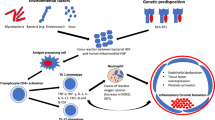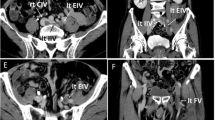Abstract
Vascular involvement is a lethal complication in Behçet disease. It is often refractory to conventional therapy such as steroids and immunosuppressants in addition to anticoagulants. We describe here successful treatment with the anti-tumor necrosis factor-alpha (anti-TNF-α) antibody, infliximab, in a patient with Behçet disease presenting with deep vein thrombosis. A 60-year-old man with Behçet disease complained of edema and pain in the lower extremities. Computed tomography revealed a thrombosis extending from the popliteal vein to the inferior vena cava at the level of the renal vein and which recurred despite combination therapy of steroid and immunosuppressants such as cyclosporine, azathioprine, and methotrexate. The patient was then administered infliximab (5 mg/kg) in weeks 0 and 2 and every 4 weeks thereafter. Clinical and laboratory findings improved after the infliximab therapy. Computed tomography of the abdomen and lower extremities showed a reduction of the thrombosis. No severe adverse events occurred during the clinical course. Although further studies are needed to confirm the efficacy and safety of its use, anti-TNF-α antibody may be worth considering as treatment for refractory venous thrombosis in patients with Behçet disease.


Similar content being viewed by others
References
Criteria for diagnosis for Behçet’s disease. International Study Group for Behçet’s Disease. Lancet. 1990; 335:1078–80.
Sakane T, Takeno M, Suzuki N, Inaba G. Behçet’s disease. N Engl J Med. 1999;341:1284–91.
Tomasson G, Monach PA, Merkel PA. Thromboembolic disease in vasculitis. Curr Opin Rheumatol. 2009;21:41–6.
Hatemi G, Silman A, Bang D, Bodaghi B, Chamberlain AM, Gul A, Houman MH, Kötter I, Olivieri I, Salvarani C, Sfikakis PP, Siva A, Stanford MR, Stübiger N, Yurdakul S, Yazici H, EULAR Expert Committee. EULAR recommendations for the management of Behçet disease. Ann Rheum Dis. 2008;67:1656–62.
Sfikakis PP, Theodossiadis PG, Katsiari CG, Kaklamanis P, Markomichelakis NN. Effect of infliximab on sight-threatening panuveitis in Behçet’s disease. Lancet. 2001;358:295–6.
Ohno S, Nakamura S, Hori S, Shimakawa M, Kawashima H, Mochizuki M, Sugita S, Ueno S, Yoshizaki K, Inaba G. Efficacy, safety, and pharmacokinetics of multiple administration of infliximab in Behçet’s disease with refractory uveoretinitis. J Rheumatol. 2004;31:1362–8.
Tugal-Tutkun I, Mudun A, Urgancioglu M, Kamali S, Kasapoglu E, Inanc M, Gül A. Efficacy of infliximab in the treatment of uveitis that is resistant to treatment with the combination of azathioprine, cyclosporine, and corticosteroids in Behçet’s disease: an open-label trial. Arthritis Rheum. 2005;52:2478–84.
Kikuchi H, Aramaki K, Hirohata S. Effect of infliximab in progressive neuro-Behçet’s syndrome. J Neurol Sci. 2008;272:99–105.
Lie JT. Vascular involvement in Behçet’s disease: arterial and venous and vessels of all sizes. J Rheumatol. 1992;19:341–3.
Koç Y, Güllü I, Akpek G, Akpolat T, Kansu E, Kiraz S, Batman F, Kansu T, Balkanci F, Akkaya S, et al. Vascular involvement in Behçet disease. J Rheumatol. 1992;19:402–10.
Boumpas DT, Austin HA 3rd, Vaughan EM, Yarboro CH, Klippel JH, Balow JE. Risk for sustained amenorrhea in patients with systemic lupus erythematosus receiving intermittent pulse cyclophosphamide therapy. Ann Intern Med. 1993;119:366–9.
Boffetta P, Kaldor JM. Secondary malignancies following cancer chemotherapy. Acta Oncol. 1994;33:591–8.
Masala A, Faedda R, Alagna S, Satta A, Chiarelli G, Rovasio PP, Ivaldi R, Taras MS, Lai E, Bartoli E. Use of testosterone to prevent cyclophosphamide-induced azoospermia. Ann Intern Med. 1997;126:292–5.
Iwata S, Saito K, Yamaoka K, Tsujimura S, Nawata M, Suzuki K, Tanaka Y. Effects of anti-TNF-alpha antibody infliximab in refractory entero-Behcet’s disease. Rheumatology (Oxford). 2009;48:1012–3.
Sfikakis PP, Markomichelakis N, Alpsoy E, Assaad-Khalil S, Bodaghi B, Gul A, Ohno S, Pipitone N, Schirmer M, Stanford M, Wechsler B, Zouboulis C, Kaklamanis P, Yazici H. Anti-TNF therapy in the management of Behcet’s disease—review and basis for recommendations. Rheumatology (Oxford). 2007;46:736–41.
Lee SW, Lee SY, Kim KN, Jung JK, Chung WT. Adalimumab treatment for life threatening pulmonary artery aneurysm in Behçet disease: a case report. Clin Rheumatol. 2010;29:91–3.
Baki K, Villiger PM, Jenni D, Meyer T, Beer JH. Behçet’s disease with life-threatening haemoptoe and pulmonary aneurysms: complete remission after infliximab treatment. Ann Rheum Dis. 2006;65:1531–2.
Endo LM, Rowe SM, Romp RL, Buckmaster MA, Atkinson TP. Pulmonary aneurysms and intracardiac thrombi due to Behçet’s disease in an African-American adolescent with oculocutaneous albinism. Clin Rheumatol. 2007;26:1537–9.
Seyahi E, Hamuryudan V, Hatemi G, Melikoglu M, Celik S, Fresko I, Yurdakul S, Yazici H. Infliximab in the treatment of hepatic vein thrombosis (Budd–Chiari syndrome) in three patients with Behcet’s syndrome. Rheumatology (Oxford). 2007;46:1213–4.
Mege JL, Dilsen N, Sanguedolce V, Gul A, Bonqrand P, Roux H, Ocal L, Inanç M, Capo C. Over production of monocyte derived tumor necrosis factor alpha, interleukin IL-6, IL-8 and increased neutrophil superoxide generation in Behçet’s disease. A comparative study with familial Mediterranean fever and healthy subjects. J Rheumatol. 1993;20:1544–9.
Durmazlar SP, Ulkar GB, Eskioglu F, Tatlican S, Mert A, Akgul A. Significance of serum interleukin-8 levels in patients with Behcet’s disease: high levels may indicate vascular involvement. Int J Dermatol. 2009;48:259–64.
Aki T, Karincaoglu Y, Seyhan M, Batcioglu K. Serum substance P and calcitonin gene-related peptide levels in Behçet’s disease and their association with disease activity. Clin Exp Dermatol. 2006;31:583–7.
Seyahi E, Yurdakul S. Behçet’s syndrome and thrombosis. Mediterr J Hematol Infect Dis. 2011;3:e2011026.
Gur-Toy G, Lenk N, Yalcin B, Aksaray S, Alli N. Serum interleukin-8 as a serologic marker of activity in Behçet disease. Int J Dermatol. 2005;44:657–60.
Conflict of interest
None.
Author information
Authors and Affiliations
Corresponding author
About this article
Cite this article
Yoshida, S., Takeuchi, T., Yoshikawa, A. et al. Good response to infliximab in a patient with deep vein thrombosis associated with Behçet disease. Mod Rheumatol 22, 791–795 (2012). https://doi.org/10.1007/s10165-011-0585-6
Received:
Accepted:
Published:
Issue Date:
DOI: https://doi.org/10.1007/s10165-011-0585-6




